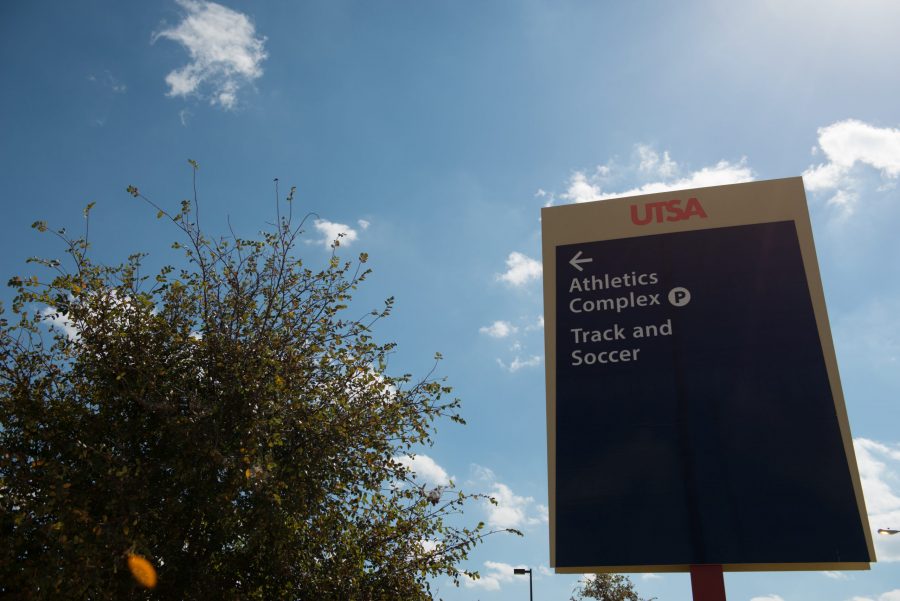UTSA Athletics requested $25 million from the 2017 City Bond initiative to help fund the second phase of the Park West Athletics Complex; city staff have offered $10 million instead.
The Park West Athletics Complex is an initiative by UTSA Athletics to centralize athletic facilities away from the Main Campus. It would serve as a competition venue for track meets, softball, soccer and tennis games.
Construction began on the Park West Athletics Complex in early 2013, and Phase I was completed in August that year. Phase I infrastructure consisted of: a track & field stadium, soccer field, 500-space parking lot, press box, fan amenities building, water filtration and detention pond and the Kyle Seale Parkway road. The construction of Park West Athletics Complex will be divided into four phases.
Phase II includes a multi-purpose team facility, practice football fields, an 800-seat softball stadium, a 21-court tennis facility and making improvements to the current track & field stadium. The total projected cost for the completion of Phase II is more than $60 million dollars.
“This is a positive for the university,” Lynn Hickey, UTSA athletic director, said. “If we can better facilities for our teams to practice in and to recruit to, then we will win more games; therefore, we put more people in the (Alamodome), therefore the city makes more money.”
Hickey described Park West as an economic opportunity for the Alamo city.
UTSA football tickets are subjected to a surcharge by the city, and a percentage of each ticket goes directly to the city. “It very much enhances a business relationship that we already have with the city,” Hickey said.
The 125-acre Park West Campus was purchased with $15 million from the Permanent University Fund through the UT System, and $4.5 million was provided by UTSA.
The majority of funding for the Park West Athletic Complex has come from city bonds and tax elections: $1.5 million came from the 2003 Bexar County bond election; $5.55 million was secured from the 2007 City of San Antonio bond election; and $15 million from the Bexar County venue tax election. Approximately $2.5 million came from San Antonio Water System and CPS Energy for connection fees.
Hickey stressed that the financial burden will not be put on UTSA students in the form of an increased athletics fee.
“We’re not eating up academic money or tuition and fee money,” she said.
Approval for athletic fee increases have to be initiated and voted on by students. The athletics fee increased in September 2007 when students voted to increase the fee from $120 to $240; of the 4,602 students who voted, 66 percent voted for and 34 percent voted against.
“We’re not trying to do something fancy or out of the question; we’re just trying to get basic facilities for our student athletes,” Hickey said.
The multi-purpose team facility—the focal point of Phase II’s building—will cost $35 million alone, requiring additional fundraising initiatives. The 2017 City Bond request is currently under review by five separate citizen committees; their recommendations will go to City Council in early December. City Council will then determine which projects to include in the 2017 City Bond election, which will occur in May.
Centralizing athletic facilities away from UTSA’s Main Campus leaves the current tennis courts and softball field open to the construction of parking lots, dormitories and academic buildings.
“All that land is really valuable,” Hickey said. “The sooner we can move out to Park West, the better for the university.”
Brad Parrott, senior associate athletic director, explained the utility of the Park West Athletics Complex for all of San Antonio.
“When completed the Park West Athletic Complex will provide state-of-the-art venues for all of San Antonio to enjoy track & field, soccer, tennis, baseball, softball, basketball and volleyball,” Parrott said. “Stadiums also can be used for concerts, graduations and other athletic and non-athletic outdoor events.”
Parrott went on to describe the economic impact of Park West Athletics Complex. “The improvements will further increase attendance at home football games and will help the City retire debt on recent Alamodome improvements,” he said.
“Already, UTSA fans are expected to pick up more than $16 million of the $50 million for improvements to the Alamodome for the 2018 NCAA Final Four.”
“These improvements bolster UTSA’s Tier One aspirations,” Parrott continues. “Athletics provides nationwide visibility for both UTSA and San Antonio. Competing with the top universities athletically provides the exposure and peer affiliation so critical to advancing as a university academically.”
“[Park West Athletic Complex] enhances the equity of your degree whether you ever go to a soccer or football game or not,” Hickey said. “The better we do, the more visibility we have, the more publicity we get, the more your degree has value. So it’s a win-win all around if we can enhance the experience for students.”







